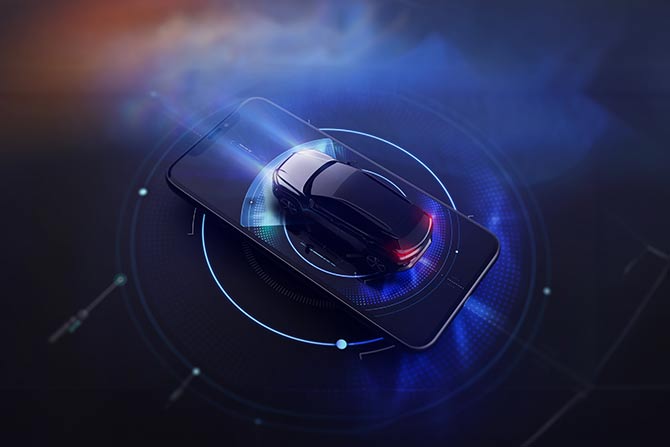Digital retailing makes it easier and more exciting for customers to shop for cars. The physical and digital processes of buying a car are merged into one seamless experience for the customer, creating more engagement and more sales with the dealership.
What is Automotive Digital Retailing?
In the early 2000s, customers would visit, on average, five dealerships before purchasing a vehicle. Today, customers may visit two dealerships before making a decision. They know what they want to buy, and they know exactly where to go to get it. With this new age of consumers searching online for the car they want, dealerships need to change how they approach vehicle sales.
Digital retailing is different from digital marketing. It’s more than just viewing an online inventory or marketing the dealership on social media. With digital retailing, customers can dive deeper into the car-buying process from the comfort of their homes. They want to buy a car the same way they buy every other product online: with an easy and streamlined checkout process and without pushy sales tactics or overly-complicated forms. They want to pick out exactly what they want and show up to your dealership ready for the keys.
Even though it may feel like dealerships are losing influence and control in the car-buying process, it doesn’t have to be a bad thing.
Omnichannel Digital Retailing
Omnichannel is defined, in terms of business strategy, as a way to provide a seamless shopping experience from your phone to the store. There is no one right way to implement omnichannel because it depends on the needs of the business and the customer. No matter how the customer wants to shop, they should remain interested and engaged across all shopping avenues.
Using omnichannel, your dealership can control how the customer interacts with your brand and inventory. You can guide customers to the general inventory, or you can be more specific and push them towards a specific model of car you are trying to sell. Customers then will have control over where they go to complete the process, but your dealership pushed them in the right direction. This way, customers create their own experience while digging deeper into the buying process. You are able to reach your customers directly without an email or phone call while the customer makes their own decisions.
The Two Types of Customers
Digital retailing gives customers the opportunity to shop exactly how they want, and there is one of two ways they usually do.
The first type of customer rushes through the whole process, wanting to make up their mind quickly. They want to offload their trade-in, secure financing, and complete the sale within a matter of hours from any device. They don’t want to be upsold and want to finish the process as quickly as they would at any other online retailer. They will only need to show up to the dealership to sign the final papers and grab the keys to their new vehicle, making the interactions in the dealership quick and minimal. They know what they want and don’t need to contemplate their decision.
The second type of customer needs time to think everything through. They need to sell themselves on the idea of buying the car before they make any big decisions, contemplating all the possible options and making sure they are getting exactly what they want. They may want to discuss their options or ask questions about the specific qualities on the cars they are analyzing. They don’t want to feel rushed for fear they will end up regretting their choice after the sale is already complete.
No matter which type of customer you get, both eventually end up at your dealership. An omnichannel provides flexibility for both types of customers to shop how they want. Whether the customer wants to race to the end of the buying process online or wants to do thorough research on various vehicles without hours of repeated conversations with a salesperson, an omnichannel solution is the way to go. A fluid omnichannel digital retailing experience allows the customer to go between your website and your dealership without losing their place or being forced to provide the same information multiple times. Customers like transparency and control, and when they have both, the chances of a sale improve exponentially.
Implementing Omnichannel Digital Strategies
There are multiple ways to implement omnichannel, but it can be difficult to know where to start. One of the most important aspects is simply knowing what the customer wants as part of their online shopping experience. Your dealership must create the strong online presence over multiple platforms that the customer is used to from other industries.
Another important aspect is ensuring the customer has a seamless transition between digital and physical channels. AI features such as virtual assistants and virtual test drives boost the customer’s experience while also collecting data. This data could be about the customer’s vehicle preferences, what specific features they’re looking for, what features they are avoiding, and more. You can then save that data and use it for the customer’s in-person experience in the dealership as well. This will assist in reducing the number of repeated conversations between the customer and salesperson and avoiding asking for information that could have already been collected earlier. With smoother transitions and faster sales, the customer will walk out of your dealership feeling satisfied with their purchase. Plus, the new technology will make the process quicker and shorten the length of time it takes to process a sale, closing the gap between the fast-paced online markets and traditional in-person stores. Plus, customers will always be happy to no longer sit in a dealership for four or more hours.
Even after the sale is complete, there are still opportunities to connect with the customer using omnichannel. The data collected from the online channels can be used to create personalized interactions and establish a long-term relationship with the customer. AI assistants can help remind customers about regular check-ups for the car and increase engagement with add-on services. The customer won’t feel like they are part of a mass email to every customer that has ever shopped at your dealership, and instead, they will feel like they have a more personal connection with your dealership, building rapport and brand loyalty.
In Closing
Like everything else, the automotive industry needs to embrace the transition to the digital world. It may be difficult to begin, but a strong digital retailing experience will smoothly integrate your dealership with an online presence. It opens the door to new ways to leverage customer data, build trust with the customer, generate leads, and increase the dealership’s closing ratio. You could be closing more deals without using any extra manpower. It may be a challenge, but making this extra effort will pay off for you and your customers.








